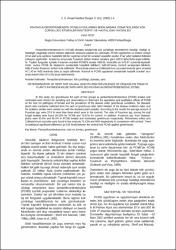| dc.contributor.author | Yiğit, Fahri | |
| dc.date.accessioned | 2020-11-20T17:50:11Z | |
| dc.date.available | 2020-11-20T17:50:11Z | |
| dc.date.issued | 2003 | |
| dc.identifier.issn | 1300-5774 | |
| dc.identifier.uri | https://app.trdizin.gov.tr//makale/TXpBeU56UTA | |
| dc.identifier.uri | https://hdl.handle.net/20.500.12809/8423 | |
| dc.description.abstract | Pentachloronitrobenzen'in (PCNB) domates seralarında kok çürüklüğü etmenlerinin niceliği, niteliği ve hastalığın yaygınlığı üzerine etkisini saptamak amacıyla yapılan bu çalışmada, PCNB uygulanmış ve kontrol amaçlı 10'ar adet sera seçilerek hastalıklı bitkiler sayılmış ve her bir seradan tesadüfen seçilen 6 'şar adet hastalıklı bitkiden izolasyon yapılmıştır. Araştırma sonucunda Fusarium türleri kontrol seralara göre %20.9 daha fazla tespit edilmiştir. Toplam funguslar içindeki Fusarium oranları PCNB'li serada %85.05, kontrolde ise %75.67 oranında kaydedilmiştir. Ayrıca PCNB ile ilaçlanmış seralardaki hastalıklı bitkilerin %85.60'sında, kontrol seralardaki bitkilerin %66.4'ünden Fusarium türleri izole edilmiştir. Rhizoctonia solani ve Colletotrichum coccodes kontrole göre sırasıyla %71.43 ve %60 oranında daha az tespit edilmiştir. Kontrol ve PCNB uygulanan seralardaki hastalık oranları ara-sında önemli ilişki (P:0.05) tespit edilmemiştir. | en_US |
| dc.description.abstract | In this study, ten greenhouses for each of two groups as pentachloronitrobenzene (PCNB) treated and nontreated were chosen for sampling and observations to determine the quantative and qualitative effects of PCNB on the root rot pathogens of tomato and the prevalence of the disease under greenhouse conditions. Six diseased plants were randomly collected from the each of greenhouse after determination of the disease incidence rates, and the isolation studies were carried out with the diseased plant samples. According to the results the average amount of Fusarium spp. were 20.9 % more than those which were in the controls. The ratio of Fusarium spp. among the total fungal isolates were found 85.05% for PCNB and 75.67% for control. In addition, Fusarium spp. from diseased plants were 85.6% and 66.4% in PCNB treated and nontreated greenhouse respectively. Rhizoctonia solani and Colletotrichum coccodes were found in less amounts 71.43% and 60% respectively in comparison with control. There no statistical significant difference (p:0.05 level) betwee'n the control and PCNB applied greenhouses. | en_US |
| dc.item-language.iso | tur | en_US |
| dc.item-rights | info:eu-repo/semantics/openAccess | en_US |
| dc.subject | Pentachloronitrobenzen | en_US |
| dc.title | Pentachloronitrobenzen (PCNB) uygulanmış seralardaki domateslerde kök çürüklüğü etmenlerinin tespiti ve hastalığının yaygınlığı | en_US |
| dc.item-title.alternative | Determination of root causal agents and prevelance of disease on tomato plants in greenhouse with applied Pentachloronitrobenzene (PCNB) | en_US |
| dc.item-type | article | en_US |
| dc.contributor.department | MÜ, Fethiye Ali Sıtkı Mefharet Koçman Meslek Yüksekokulu, Bitkisel Ve Hayvansal Üretim Bölümü | en_US |
| dc.contributor.institutionauthor | Yiğit, Fahri | |
| dc.identifier.volume | 17 | en_US |
| dc.identifier.issue | 31 | en_US |
| dc.identifier.startpage | 1 | en_US |
| dc.identifier.endpage | 4 | en_US |
| dc.relation.journal | Selçuk Üniversitesi Ziraat Fakültesi Dergisi (:Selçuk Tarım ve Gıda Bilimleri Dergisi) | en_US |
| dc.relation.publicationcategory | Makale - Ulusal Hakemli Dergi - Kurum Öğretim Eleman | en_US |


















